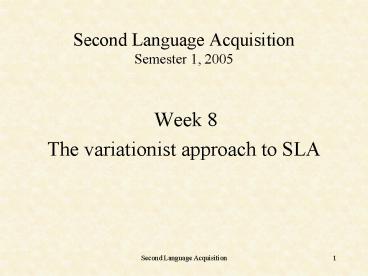Second Language Acquisition Semester 1, 2005 - PowerPoint PPT Presentation
1 / 16
Title:
Second Language Acquisition Semester 1, 2005
Description:
The notion of an interlanguage assumes that L2 development is not ... Beebe & Zuengler, 1983. Second Language Acquisition. 12. Restructuring as variation (p213) ... – PowerPoint PPT presentation
Number of Views:74
Avg rating:3.0/5.0
Title: Second Language Acquisition Semester 1, 2005
1
Second Language Acquisition Semester 1, 2005
- Week 8
- The variationist approach to SLA
2
Variation
- The notion of an interlanguage assumes that L2
development is not arbitrary. However, at the
same time, it is clear that there is a great deal
of variability in the way people learn a second
language. People learn at different rates, follow
different orders and ultimately arrive at
different places along the curve of L2
development.
3
The variationist perspective
- The basic premise of sociolinguistic-based SLA
research is that second language data do not
represent a static phenomenon, even at a single
point in time. Many external variables (such as
the specific task required of a learner, social
status of the interlocutor, gender differences,
and so forth) affect learner production. - (Gass Selinker, 2001, p. 222)
4
- Language learning as the development of
function-form mappings (e.g., the Competition
Model) - subject verb form
- Daddy hit
- agent action function
5
Two kinds of variability
- Systematic When two or more sounds vary
contextually. Can be due to linguistic or
sociolinguistic factors. - Non-systematic Free variability among forms
6
Systematic variation
- linguistic Mr. Smith lives in Brisbane. gt
- Contextual Mr. Smith who live_in Brisbane.
- situation levels of formality shift from
vernacular to formal - Individual age, motivation, personality etc.
7
Non-systematic variation
- free variation When a new form exists
along side other forms, e.g., use of should/had
better/better/have to/must. Usually temporary. - performance variation result of specific context
demands
8
The way in which variability is accounted for in
SLA theory depends on how L2 'competence' is
defined.
- Linguistic competence vs. Communicative
competence - Chomsky Labov
- structuralist functionalist
- competence/performance competence to
perform - all V non-systematic V essential
part of theory - discrete, invariant rules
9
Communicative competence
- Knowledge that enables learners to comprehend and
produce the L2. - linguistic pragmatic
- sociolinguistic strategic
10
Linguistic context as a source of variation
- Phonological environment as a constraint on /s/
plural marking. - Factor of plural usage
- Preceding segment
- Nonsibilant fricative (/f/, /v/) 78
- Vowel 71
- Nasal (/m/, /n/) 58
- Lateral (/l/) 42
- Following segment
- Vowel or glide (/w/, /y/) 70
- Pause 64
- (Young, 1991)
11
Social context as source of variation
- Percentage of Chinese variants used by bilingual
Chinese-Thai subjects with Thai and Chinese
interviewers - Interviewer
- Variant Thai Chinese
- ? 9.5 16.1
- k 5.8 10.7
- Beebe Zuengler, 1983
12
Restructuring as variation (p213)
- Time 1 Time 2 Time 3 Time 4
- I am no go. I am no go. I am no
go. I am no go. - No look. No look. Dont
look. Dont go. - I am no run. I am dont run. I am dont
run. I am no run. - No run. Dont run. Dont run.
Dont run. - Indicative, Imperative
- Ellis, (1985) Understanding second language
acquisition. Oxford University Press
13
Stages of Interlanguage Variation (p 238)
- Stages
- Initial no for all forms
- Free variation no/dont interchangeably
- Systematic variation dont / imperatives
- no dont / indicatives
- Categorical use dont / imperatives
- no / indicatives
14
Example of IL variation
- Huebners (1983) longitudinal study of Ge,
a Hmong L1 immigrant from Laos living in Hawaii. - is(a) initially used to mark topic-comment
boundaries and developed over time into the
copula. - ai werk everdei, isa woter da trii
- As for the work I do everyday, it
involves watering the plants - Similar patterns for the article da
and pronominal reference
15
What is the role of social and cultural context
in SLA theory?
- What is the domain of SLA theory or, in other
words, what determines L2 proficiency? - Abstract linguistic knowledge?
- (linguistically or cognitively based)
- Social and cultural context?
16
End of Week 8 lecture slides.































